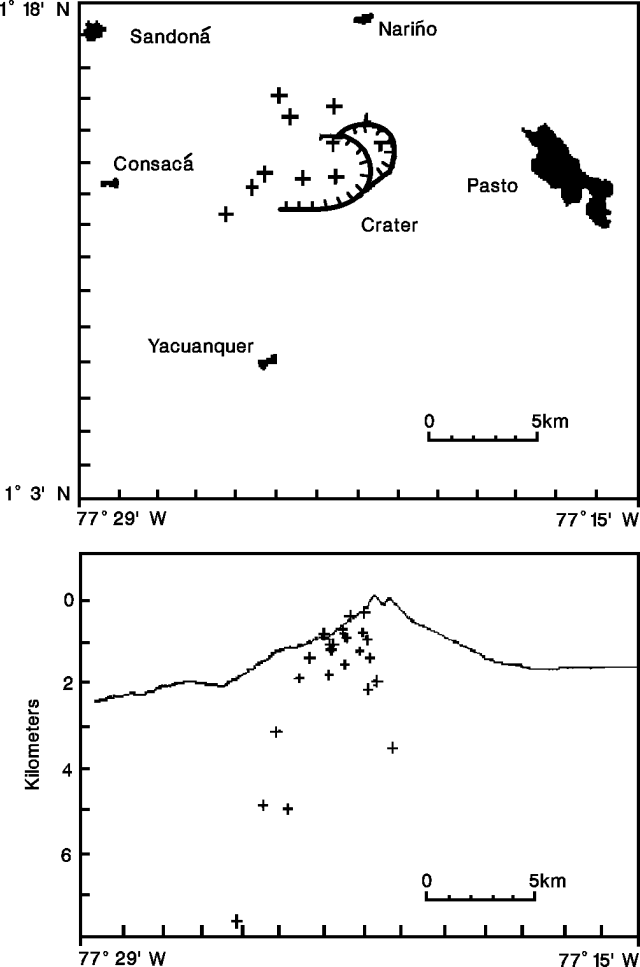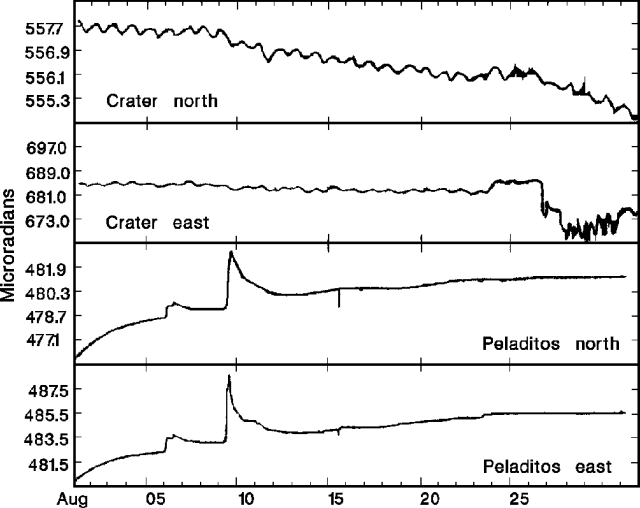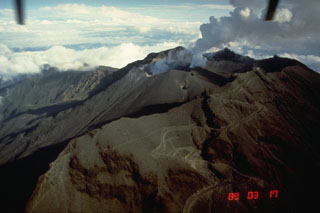Report on Galeras (Colombia) — August 1992
Bulletin of the Global Volcanism Network, vol. 17, no. 8 (August 1992)
Managing Editor: Lindsay McClelland.
Galeras (Colombia) Ash ejection; seismicity and SO2 emission decline
Please cite this report as:
Global Volcanism Program, 1992. Report on Galeras (Colombia) (McClelland, L., ed.). Bulletin of the Global Volcanism Network, 17:8. Smithsonian Institution. https://doi.org/10.5479/si.GVP.BGVN199208-351080
Galeras
Colombia
1.22°N, 77.37°W; summit elev. 4276 m
All times are local (unless otherwise noted)
Seismicity in August was at the lowest levels since monitoring began, but there was an increase in high-frequency events. On 1 August, a high-frequency earthquake centered 7 km W of the active cone was felt in the city of Pasto. During August, four swarms were detected, similar to those recorded a few hours before the 16 July eruption. The swarms were centered NW of the crater at depths of 2.5-5.0 km (figure 59); magnitudes were generally ~0.4, with the strongest shocks reaching M 2.3. The number and energy release of long-period earthquakes were the lowest since February 1989.
 |
Figure 59. Epicenters (top) and depths (bottom) of seismic activity at Galeras, August 1992. Courtesy of INGEOMINAS. |
Deformation measured by two electronic tiltmeters near the summit (Crater and Peladitos), and the short leveling-line vector (Las Piedras), was low compared to that of September and October 1991, associated with dome emplacement. A strong offset at Peladitos on 9 August coincided with one of the swarms of high-frequency events. Deformation remained relatively stable at Crater until a sharp change occurred on 24 August (figure 60).
 |
Figure 60. Deformation data from the Crater and Peladitos electronic tiltmeters, 0.9 km NE and 1.5 km SE, respectively, of the crater at Galeras, August 1992. Courtesy of INGEOMINAS. |
COSPEC data showed SO2 emissions of ~35 t/d, the lowest values since monitoring began in early 1989. Ash emission associated with a long-period seismic event was observed at 1535 on 11 August. Geologists noted that pulses of great activity, as from 1924-36, alternate with periods of minimum activity, and that the present decline in activity is consistent with the historical behavior of Galeras.
Geological Summary. Galeras, a stratovolcano with a large breached caldera located immediately west of the city of Pasto, is one of Colombia's most frequently active volcanoes. The dominantly andesitic complex has been active for more than 1 million years, and two major caldera collapse eruptions took place during the late Pleistocene. Long-term extensive hydrothermal alteration has contributed to large-scale edifice collapse on at least three occasions, producing debris avalanches that swept to the west and left a large open caldera inside which the modern cone has been constructed. Major explosive eruptions since the mid-Holocene have produced widespread tephra deposits and pyroclastic flows that swept all but the southern flanks. A central cone slightly lower than the caldera rim has been the site of numerous small-to-moderate eruptions since the time of the Spanish conquistadors.
Information Contacts: J. Romero, INGEOMINAS - Observatorio Vulcanólogico del Sur.

